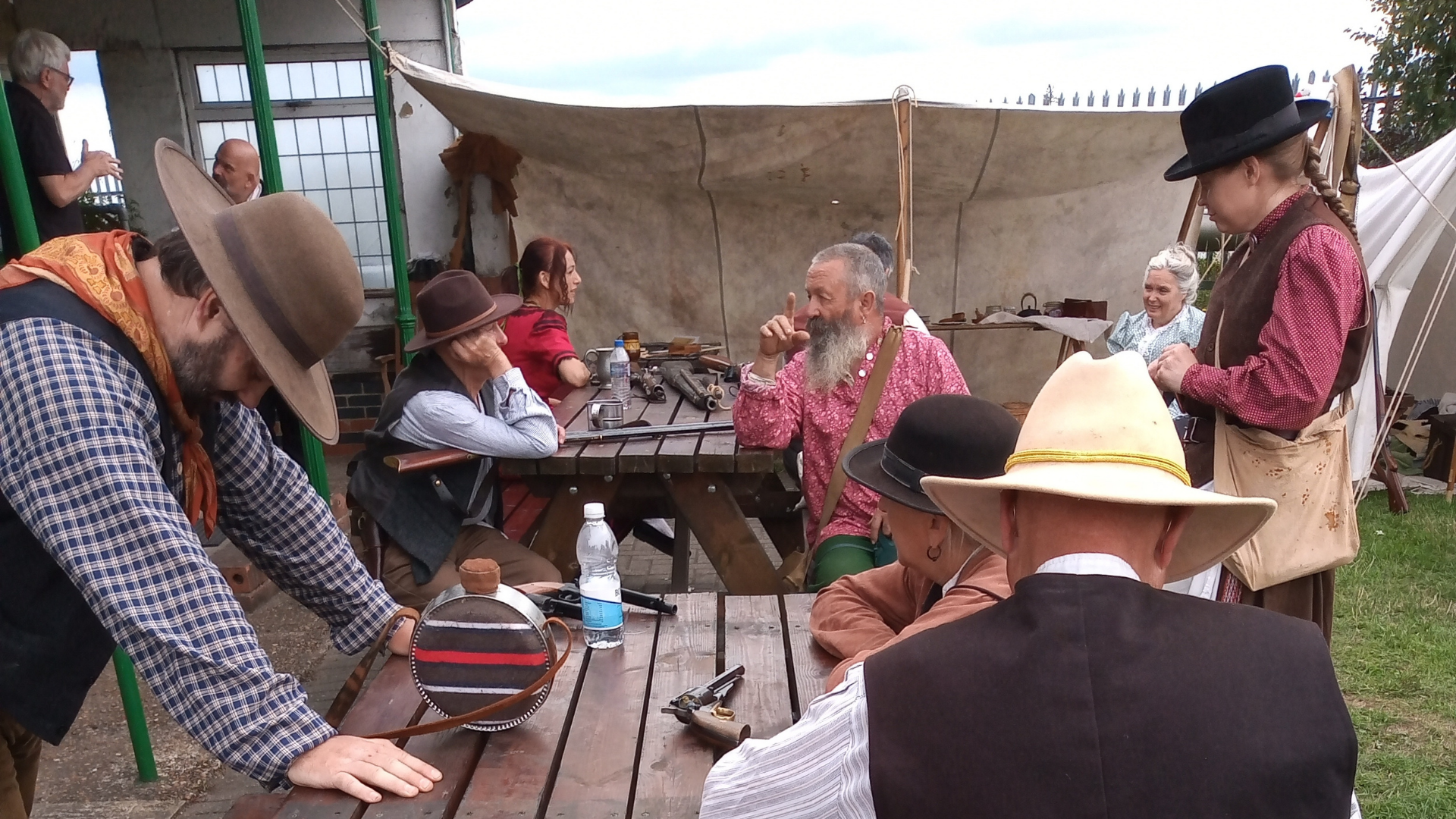Wild West
Written by our Writer-in-Residence at Sittingbourne Steam Railway, Dan Thompson

Written by our Writer-in-Residence at Sittingbourne Steam Railway, Dan Thompson
Today, the familiar taste of woodsmoke overlays the smell of salty river creek mud.
Bonfire, and cigarette smoke. A rough roll-up made by dirty fingers. Turner Blue hand-rolling tobacco, mugs of strong sugary tea, and imagined dreams of the Black Hills in South Dakota.
Spearfish. Ed Macintosh on KBFS 1450AM playing Joe Maphis and Bobby Goldsboro and Glen Campbell, speedway and livestock markets in between the songs. Prairie Hills Transit Co. buses, passing Matthews Opera House and the old Lown General Store with its facade of stone quarried from Higgins Gulch and Lookout Mountain. Wolzmuth Hardware. State University. Wrigley’s Winterfresh and Hershey’s Kisses and real Coke. But it’s not that Spearfish, not the modern-day town.
We’re in the Spearfish Creek, Black Hills of 1876.
Twenty kilometres from Fred and Moses Manuel’s Homestake claim – the hard source of all the loose placer gold found down Deadwood and along the Whitewood Creeks, free-milling two and a half kilometres down, a tenth of all the world’s gold supply for the next 125 years from their one mine. A hole that filled the Hearst family vaults.
On Sioux lands, though – so that every claim was theft. The Treaty of Fort Laramie confirmed that ownership, signed by Red Cloud himself. The Great Sioux Nation. People who hold other humans equal to nature and the spirits – all are family, kin, friends or future friends. Kinship not fixed but rippling outwards from the centre across the whole nation. “I can safely say that the ultimate aim of Dakota life, stripped of accessories, was quite simple: one must obey kinship rules; one must be a good relative,” said Ella Cara Deloria.
But all that gold – just the chance that you might find it, this might be the stake that takes you back home – the imagined weight of gold balanced against a paper treaty. Metal’s heavier than words, each claim more important than kinship.
Custer had come first. The Black Hills Expedition of 1874. Orders to explore the uncharted hills, following stories of gold, the small amounts that have already drifted eastwards. One thousand men – geologists, infantry, cavalry, miners, and journalists. And the same number of horses and mules, carrying two months’ food supplies. Over a hundred wagons, artillery. And Custer’s favourite scout, Bloody Knife,- half Arikara, half Sioux. Less expedition than invasion.
People had been to the Black Hills before: they hadn’t come back. Custer found traces of their passing in the rutted tracks left by wagons, the carved-out trenches filled with sunflowers. But he didn’t find the wagons, or the people.
But the Black Hills Expedition were out there for sixty and some days, and Custer sent a message back to Fort Laramie by scout, and telegraphs ran east from there – ‘examinations at numerous points confirm and strengthen the fact of the existence of gold in the Black Hills’.
And those words started the Black Hills Gold Rush. And that would end in the Black Hills War, Lakota Sioux and Northern Cheyenne against the United States. The Battle of the Greasy Grass – Custer’s Last Stand. The casual betrayal of the Sioux started by Custer’s telegraph brought about his own end.
Stories of the Wild West, of the Gold Rush, of frontier towns and tough people, live on. Something about the free-rolling spirit, the easiness and the anarchy, the idea that maybe anyone can hit gold, or be a hero, appeals across cultures and through generations. So today, Milton Creek stands in for Spearfish Creek. The Sittingbourne and Kemsley Light Railway’s saddle-tanked steam engine Premier stands in for the Treasure Coach. A dozen re-enactors – veterans of the American Civil War and D-Day, a handful of Swale’s 18th century pirates – are living like it’s 1876. Even if they do get a sound system out in the evenings, when the visitors have gone home, rather than play fiddles. They’re still sleeping under canvas. And if a couple of the older members have a camper van – well, what’s that if not a covered wagon?
But broadly speaking they’re true to history – more true than TV or film. Rough tweed, heavy cotton, collarless shirts, cuffs frayed and elbows scuffed and darned. “Out here there are no launderettes,” one says drily. Square cut waistcoats and watch-chains. Holsters worn high, felt hats pulled down low. Old, weathered, broken-in, comfortable.
And that’s true of the friendship between re-enactors too. While – for display, for performance – they’ll gun each other down, five or ten times a day, really they have each other’s backs.
Old friends, they talk easily of death and loss, of mourning a wife. Of how the Civil War group they used to belong to or this Wild West society, is a chosen family, in an echo of the gay activists of the 1970s who redefined family not as genetics but as choice. These re-enactors have been through things, side-by-side, helped each other out, picked each other up after they’ve been shot down. Been a long way together. Fifteen or twenty years they’ve been out here in Spearfish Creek, a frontier mining town, far longer than the sixty days of the Black Hills Expedition.
They have Stetson hats, the boots, and Colt revolvers, for sure, but in that rough-made kinship, in being good friends, in making a family together, they’re more like Native Americans than Cowboys.
Thanks to Simon from Spearfish Creek Living History for a history lesson, and Ed Macintosh from Dirt Road Radio for playing my request.